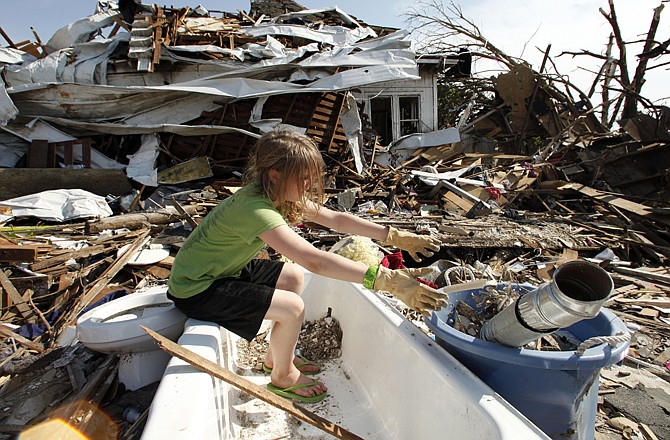JOPLIN (AP) - As residents confront a gigantic cleanup following the tornado that savaged Joplin, experts say environmental dangers could lurk amid the mountains of debris in the southwestern Missouri city and even in the water and air.
Damage from tornadoes, like floods and hurricanes, often goes beyond what is readily visible. Liquid fuels and chemicals can leak from ruptured containers and contaminate groundwater. Ruined buildings may contain asbestos. Fires can generate smoke containing soot, dioxins and other pollutants. Household, industrial and medical wastes are strewn about.
In the initial hours after the May 22 twister, the odor of gasoline was evident around several flattened service stations. A large fire burned for hours near the devastated St. John's Regional Medical Center. Heavy rains caused flash flooding, possibly fouling local waterways.
Yet U.S. Environmental Protection Agency teams sent to inspect the damage turned up no serious pollution issues in the first week, although the search was continuing, spokesman Chris Whitley said.
"Until the systematic assessment of the tornado's impact area is complete, it is not possible to fairly evaluate levels of risk or priorities for environmental response," he said in an email.
The nation's deadliest single tornado in more than six decades packed winds of more than 200 mph and measured a half-mile across. It killed at least 132 people and injured more than 900 while severely damaging or leveling many buildings in the city's industrial corridor, which includes chemical suppliers, natural gas companies and paint manufacturers. An estimated 8,000 structures were destroyed.
A brief anhydrous ammonia leak from a valve at the Jasper Products trucking company was sealed by the company's hazardous materials crew. Otherwise, an EPA emergency response team combing the area last week found no significant toxic releases after checking 40 sites, coordinator Eric Nold said.
"If there was a screaming release that needed to be found, it would have been by now," he said. His two-person team looked at underground storage tanks, wastewater treatment plants and other potential pollution sources.
"Given this size tornado, there could have been a lot worse from a chemical release standpoint," Nold said over the sound of crunching metal as bulldozers worked nearby.
Many companies sent their own environmental response teams to the disaster area.
Among other places being examined were the destroyed hospital and a Superfund site in western Jasper County tainted by years of lead and zinc mining. The tornado missed piles of waste material from the mines, but touched down in nearby neighborhoods where clean layers of topsoil were placed atop polluted soils between 1995 and 2002, Whitley said.
Property owners and emergency workers were advised to use caution when removing debris from the area, he said. Lead exposure happens primarily by ingesting contaminated soil on dirty hands - a particular danger for children - and breathing contaminated dust.
Another likely hazard is oil spilled from downed electrical transformers, some of which contain highly toxic polychlorinated biphenyls, or PCBs. It wasn't immediately clear how many were blown down during the storm.
But a spokesman for Alabama Power, that state's largest electric utility, said more than 4,000 transformers had been recovered there following a series of tornadoes last month. Some of the older ones contained trace amounts of PCBs, spokesman Michael Sznajderman said. All were bagged and sent to a licensed recycler, while oil and dirt around fallen transformers were hauled to a hazardous waste landfill.
Some of the greatest long-term environmental risks from tornadoes come during the cleanups, experts said.
The Missouri Department of Natural Resources last week announced a temporary waiver of some solid waste and air pollution regulations for Jasper and Newton counties, where the tornado struck. The move allows landfills to accept brush, yard waste, appliances and other materials that normally wouldn't be allowed, although recycling of appliances is encouraged. It permits burning of tree and brush waste under certain conditions.
Also waived was a requirement that state-certified supervisors be involved in removal of material containing asbestos, a fiber that can cause lung diseases including cancer. Federal asbestos regulations remain in place.
Relaxing the rules during an emergency is understandable, but improper handling or disposal of waste material could make a bad situation worse, said David Carpenter, director of the Institute for Health and the Environment at the University at Albany-SUNY.
If plastics, asbestos material or treated wood find their way into brush fires, they could produce emissions particularly dangerous for people with asthma or respiratory diseases, he said.
"I know there's a huge amount of debris, but finding a landfill in a valley someplace where you can put it and cover it over is a lot wiser than burning it," Carpenter said. "There are health hazards associated with burning debris of any sort."

